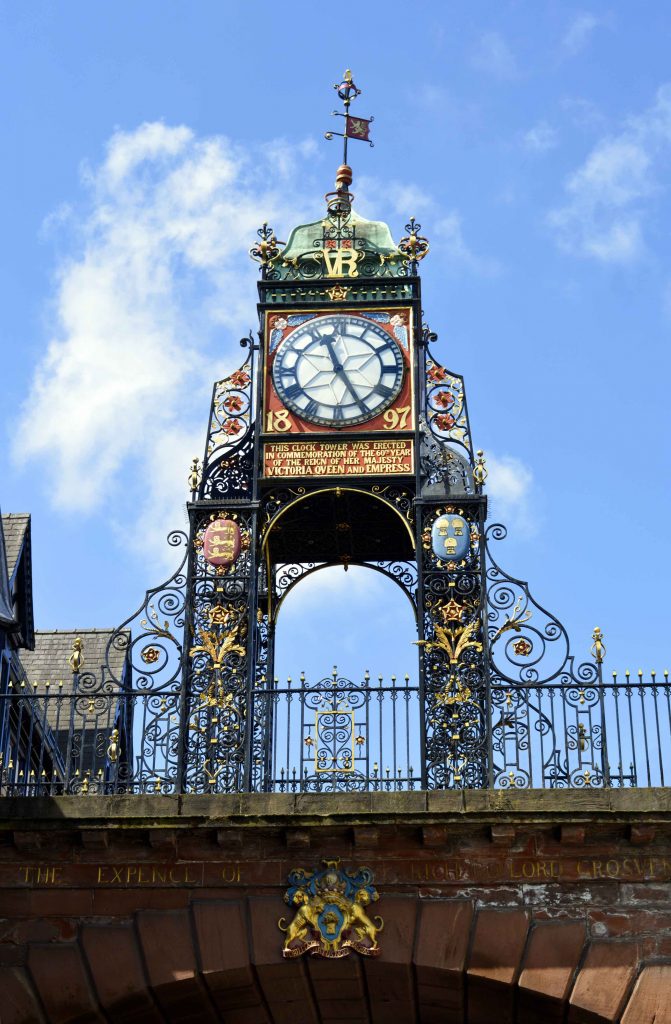The Eastgate Clock stands as a turret clock positioned above the Eastgate within the historic walls of Chester. With our Clockmakers completing the annual service of the clock last month, we thought we’d share some of this incredible clock’s history:
While the initial gate was of Roman origin, the current structure, constructed during the Georgian era, was designed to accommodate coaches. The clock was not incorporated until the Victorian period, commemorating Queen Victoria’s diamond jubilee.
The Eastgate Clock has served as a significant entrance to the city of Chester since Roman times, functioning as the eastern gateway to the fortress. It retained its prominence throughout the medieval period, showcasing intricate design reminiscent of the King’s Gate at Caernarfon Castle. This architectural resemblance indicates construction likely took place in the early fourteenth century. In 1768, a bridge was erected to carry the city walls’ walkway across Eastgate Street, replacing the previous gateway.
After the opening of the new Town Hall in 1869 by the Prince of Wales, there arose suggestions to enhance the rather plain Eastgate bridge as a tribute to the Prince’s visit. Architect John Douglas of Chester was tasked with creating plans for this purpose. Several plans were drafted, yet they only came to fruition with the inspiration spurred by Queen Victoria’s Diamond Jubilee. While various commemorative ideas were considered, including a statue of Queen Victoria, a clock on the Town Hall, and contributions to healthcare institutions, the Eastgate clock plan gained eventual support.

Eastgate clock tower in Chester
A committee formed for this purpose reviewed an initial stone design by Douglas in March 1897. However, a wooden model placed on the bridge indicated that the proposed stone tower would block excessive light from surrounding structures. Consequently, a new design was developed in December 1897, following another meeting with John Douglas. This design integrated an ornate metal framework to hold the clock. The committee approved this tower design in March 1898. Local craftsmanship was employed in the tower’s creation:
- The tower’s ironwork was crafted at the Handbridge forge, located less than half a mile from Eastgate, by James Swindley (cousin of John Douglas).
- The cast iron inscriptions for the tower were produced by the Coalbrookdale Iron Company.
- A clock order had previously been placed with JB Joyce & Company, whose clock was engraved with ‘JOYCE WHITCHURCH 1895’ on its setting dial.
Colonel Evans-Lloyd, a donor, presented the clock to the mayor as a tribute to his native city. He expressed hope that the clock would provide comfort, convenience, and aesthetic value to both residents and tourists. He commended the craftsmanship of Mr. Swindley and Mr. Joyce, highlighting their exceptional work.
During a ceremony, the Mayoress pulled a tassel, set by Mr. Joyce, initiating the clock’s operation. The clock was a weight-driven timepiece with a pinwheel, deadbeat escapement. It featured a unique design with an extra wheel in the train, allowing for eight-day operation with a short weight drop. The tower was ingeniously constructed to enable technicians to stand within it for maintenance and winding.
On July 28, 1955, the entire structure of the clock and gateway achieved Grade 1 listed status. The ornate wrought-iron pavilion, upheld by open-work wrought-iron pylons, held a 4-dial clock by JB Joyce of Whitchurch. The clock tower’s plinth bore inscriptions commemorating Victoria’s 60-year reign, the mayors of 1897 and 1898, the clock’s benefactor Edward Evans-Lloyd, and the completion date in 1899. Each clock face displayed the year 1897, while filigree corner panels added to its charm. The cupola roof, capped by a weathervane, crowned the structure.